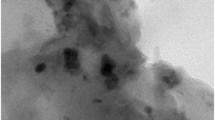Abstract
To meet current requirements for the development of novel materials possessing high specific properties and low environmental impact, this paper deals with the study of the incorporation of hollow glass microspheres (HGM) and piassava fibers into homo- (PPH) and co-polypropylene (PPC) matrices. Various compositions of HGM/piassava fiber-reinforced PP composites were extruded and injection molded to obtain their rheological, mechanical and morphological properties. The formulation with 60 wt% of PPC or PPH, 20 % wt of coupling agent, 5 wt% of HGM and 15 wt% of piassava fiber reached the highest tensile and flexural modulus for both PPH- and PPH-based composites. Furthermore, the PPC-60/20/5/15 composition presented flexural strength higher than that of the neat PPC. Morphological analysis revealed that the incorporation of the coupling agent enhanced adhesion between mineral filler and piassava fiber embedded into PPH or PPC matrices.











Similar content being viewed by others
References
Saha P, Chowdhury S, Roy D, Adhikari B, Kim JK, Thomas S (2016) A brief review on the chemical modifications of lignocellulosic fibers for durable engineering composites. Polym Bull 73(2):587–620
Almeida Júnior JHS, Amico SC, Botelho EC, Amado FDR (2013) Hybridization effect on the mechanical properties of curaua/glass fiber composites. Compos Part B Eng 55:492–497
Karaduman Y, Onal L, Rawal A (2015) Effect of stacking sequence on mechanical properties of hybrid flax/jute fibers reinforced thermoplastic composites. Polym Compos 36(12):2167–2173
Pigatto C, Almeida Júnior JHS, Ornaghi Júnior HL, Rodríguez AL, Mählmann CM, Amico SC (2012) Study of polypropylene/ethylene-propylene-diene monomer blends reinforced with sisal fibers. Polym Compos 33(12):2262–2270
Doumbia AS, Castro M, Jouannet D, Kervoëlen A, Falher T, Cauret L, Bourmaud A (2015) Flax/polypropylene composites for lightened structures: multiscale analysis of process and fibre parameters. Mater Des 87:331–341
Pedrazzoli D, Pegoretti A (2014) Long-term creep behavior of polypropylene/fumed silica nanocomposites estimated by time-temperature and time-strain superposition approaches. Polym Bull 71(9):2247–2268
Hu Y, Mei R, An Z, Zhang J (2013) Silicon rubber/hollow glass microsphere composites: influence of broken hollow glass microsphere on mechanical and thermal insulation property. Compos Sci technol 79:64–69
Budov VV (1994) Hollow glass microspheres. Use, properties, and technology (review). Glass Ceram 51(7–8):7–11
Li J, Luo X, Lin X (2013) Preparation and characterization of hollow glass microsphere reinforced poly(butylene succinate) composites. Mater Des 46:902–909
Almeida Júnior JHS, Ornaghi Júnior HL, Amico SC, Amado FDR (2012) Study of hybrid intralaminate curaua/glass composites. Mater Des 42:111–117
Ornaghi HL Jr, Zattera AJ, Amico SC (2015) Dynamic mechanical properties and correlation with dynamic fragility of sisal reinforced composites. Polym Compos 36(1):161–166
Liu L, Yu J, Cheng L, Qu W (2009) Mechanical properties of poly(butylene succinate) (PBS) biocomposites reinforced with surface modified jute fibre. Compos A 40:669–674
El-Sabbagh A, Steuernagel L, Ziegmann G (2013) Ultrasonic testing of natural fibre polymer composites: effect of fibre content, humidity, stress on sound speed and comparison to glass fibre polymer composites. Polym Bull 70(2):371–390
Saheb DN, Jog JP (1999) Natural fiber polymer composites: a review. Adv Polym Technol 18(4):351–363
Elzubair A, Bonelli CMC, Suarez JCM, Mano EB (2007) Morphological, structural, thermal and mechanical characterization of piassava fibers. J Nat Fibers 4(2):13–31
Elzubair A, Suarez JCM (2012) Mechanical behavior of recycled polyethylene/piassava fiber composites. Mat Sci Eng A Struct 557:29–35
Nascimento DCO, Ferreira AS, Monteiro SN, Aquino RCMP, Satyanarayana GK (2012) Studies on the characterization of piassava fibers and their epoxy composites. Compos Part A Appl S 43(3):353–362
Silva LV, Almeida JHS Jr, Angrizani CC, Amico SC (2013) Short beam strength of curaua, sisal, glass and hybrid composites. J Reinf Plast Compos 32(3):197–206
Ornaghi Júnior HL, Silva HSP, Zattera AJ, Amico SC (2011) Hybridization effect on the mechanical and dynamic mechanical properties of curaua composites. Mater Sci Eng A 528:7285–7289
Doumbia AS, Bourmaud A, Jouannet D, Falher T, Orange F, Retoux R, Le Pluart L, Cauret L (2015) Hollow microspheres e poly-(propylene) blends: relationship between microspheres degradation and composite properties. Polym Degrad Stabil 114:146–153
Liang JZ (2005) Tensile and flexural properties of hollow glass bead-filled ABS composites. J Elastom Plast 37(4):361–370
Xiao J, Chen Y (2015) New micro-structure designs of a polypropylene (PP) composite with improved impact property. Mat Lett 152:200–212
Zokaei S, Lesan Khosh RM, Bagheri R (2007) Study of scratch resistance in homo- and co-polypropylene filled with nanometric calcium carbonate. Mater Sci Eng A 445–446:526–536
Patankar SN, Das A, Kranov YA (2009) Interface engineering via compatibilization in HDPE composite reinforced with sodium borosilicate hollow glass microspheres. Compos Part A Appl S 40:897–903
Acknowledgments
The authors are grateful to CAPES and CNPq for the financial support.
Author information
Authors and Affiliations
Corresponding author
Rights and permissions
About this article
Cite this article
Borges, T.E., Almeida, J.H.S., Amico, S.C. et al. Hollow glass microspheres/piassava fiber-reinforced homo- and co-polypropylene composites: preparation and properties. Polym. Bull. 74, 1979–1993 (2017). https://doi.org/10.1007/s00289-016-1819-8
Received:
Revised:
Accepted:
Published:
Issue Date:
DOI: https://doi.org/10.1007/s00289-016-1819-8




